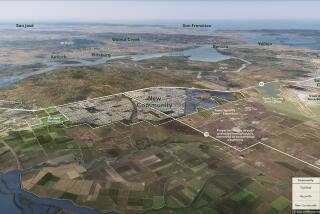Don’t Rush San Simeon Plan
- Share via
Near the village of San Simeon and the fabled Hearst Castle, the Hearst Corp. wants to build a sprawling resort community on some of its 77,000 acres. Where there is now mile after mile of rolling sea, sculpted rock, coastal moors and vistas, the Hearst folks would put a 27-hole golf course, several hotels, a dude ranch, an arcade of shops and restaurants and employee housing for up to 1,000 people. The project promises $3 million a year in new tax revenues for the county and new jobs paying a total of $13 million for local residents.
The plan, affecting one of the state’s wild and empty expanses of coast, has been adopted by San Luis Obispo County and is headed to the California Coastal Commission. It will pose one of the biggest challenges to face the commission, which is responsible for protecting the legendary California coastline.
As one commission planner noted, the Hearst project presents “a classic test of the coastal act.” That act, passed by voters in 1972, empowered the commission to elevate the public’s interest in preserving irreplaceable scenic and recreational qualities of our shoreline, while still permitting the reasonable economic use of coastal property by private landholders. This project may fall short in meeting the balance called for by the act.
Earlier this summer, the broad outlines of the proposed Hearst Corp. project passed muster with the county Board of Supervisors as part of the county’s overall coastal plan. To ensure that the public’s right to use and enjoy the coast is maintained, state law requires the Coastal Commission to review the county’s plan.
This process promises to be fiery. Much of the development, including shops, restaurants, two hotels and the golf course, would cluster on the ocean side of California 1. Apart from marring the area’s unique scenic quality, the scale of development raises profound concerns about the public’s right of coastal access.
The commission has received hundreds of letters from worried residents asking the agency to hold hearings in San Luis Obispo, which it seems inclined to do. Environmental groups have sued, contending the county did not follow applicable local and state law.
The panel did not take up this matter at its meeting in Los Angeles last week; that is likely to happen early next year, giving staff and commissioners time to study the details. Such serious deliberation is clearly appropriate for a project of this size and import. So is a skeptical eye.
More to Read
Inside the business of entertainment
The Wide Shot brings you news, analysis and insights on everything from streaming wars to production — and what it all means for the future.
You may occasionally receive promotional content from the Los Angeles Times.










